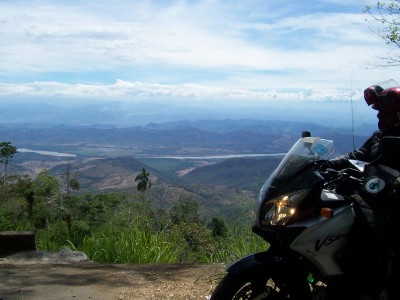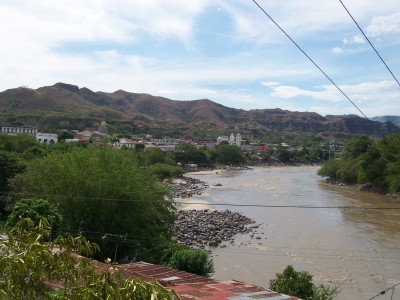Colombia

View over the Valley - North of Bogota
Miss Piggy and her mounts rolled gently to a stop only inches from the deep gully at the edge of the road yet another checkpoint, 'Routine' we thought after riding almost 2000km from Bogota to Cartegena and return we had become used to the constant military and police presence on the roads.

Friendly Colombian Soldiers
This time we were wrong! The young number 2 hair cut officer greeted us innocently enough, offering his hand and the customary 'Buenos'.
As we dismounted our Suzuki his tone began to change. '¡Documentos por favor!' he barked out. We handed him our documents, which had previously passed the scrutiny of numerous police and millitary personnel.
He flipped through the papers. '¿Donde esta seguro?' he questioned. Seguro? (third party insurance) we thought, what seguro? Nothing had been mentioned to us at customs and immigration or for that matter by anyone since! We both looked at him dumbfounded.
He went on to explain that it was necessary to purchase insurance in Colombia. Our guide book had vaguely mentioned third party insurance, however, from what we had read, we considered that it was not compulsory and we had put it out of our minds.
We both continued to act dumb. Grant with below average Spanish and Jules with her Spanish quickly deteriorating the Officer steadfastly held on to our documents while demanding we go to the nearest town, one hour away, to purchase insurance. We questioned him 'Can we buy insurance there?' To which he replied 'No lo se' (I dont know).... not very reassuring for a two hour return ride!

Sheltering from the rain after the police check
Asking if we could pay an 'on-the-spot fine' he looked at us quite daunted by the prospect of giving us a ticket, even though the fine book sat plainly on the bonnet of his vehicle.
All three of us stood about in the hot sun for about thirty minutes or so. He continuing his demands, we continuing to plead ignorance. Julie began to feign a fainting spell while Grant appeared more anxious. Eventually Grant asked, with as much politeness as he could muster, for the documents and to our surprise the officer handed them back.
We milled about for a few minutes while the officer answered his cell phone, half way through his phone conversation he looked over to us and dismissed us with a wave of his hand. We were on the bike and dissapearing down the road in record time.

Truck Crash - Caucasia
The Colombian temporary importation process is quite easy, however, very time consuming, taking us approximately 5 hours.
* Before leaving the airport go to the DIAN Office to declare the bike and complete their paperwork.
* Go to the Freight Agent (in this case we used Girag) for the necessary customs paperwork (make sure they give you all of it as Customs will send you back).
* Walk across to customs and fill in papers, make copies of title, rego, licence, passport etc etc etc.
* Return to Girag and wait for Customs Inspection.
* When Customs Inspector finally arrives check bike over to ensure clearance.
* Go back to Customs Office for more waiting and final signing of paperwork and make any additional copies they require.
* Return to Girag with all paperwork and wheel the bike out of the warehouse and down the steps.
NB: Customs may demand that you purchase a customised reflective vest (one for each passenger) with your number plate on it as per the locals. This is not necessary, just agree with them and once you have the papers in your hand... leave! We have never once been chastised for not having the vests as foreginers.

Fully loaded and down the steps - Girag Office, Bogota
Grant had been sick and running a high fever upon arriving in Bogota. Our run to Cartegena via Medellin consisted of short days on the road while he was running high fevers then he would sleep for the rest of the day while Jules unpacked the bike and shopped for food, juice, medicine etc. (You can buy almost anything over the counter of the Droguria including anti-biotics! - No prescription required.)

Medellin City
The scenery was spectacular decending the mountains to Medellin, the Flower Capital of Colombia, then through the hot and humid valleys to the coast.

Residence in the mountains
Grants fever had abated by the time we had reached Cartegena, however, his chest infection was not clearing and being asthmatic it was necessary to see a Doctor.

Furniture Stores - Cartegena
As a general rule, in Colombia, small clinics and private surgeries do not exist and most doctors (ie 65%) work in the main city hospitals and the rest work in rural areas. It was necessary for us to visit the emergency room at the Bocagrande Hospital, where we were attended to within 15 minutes of arrival, this is the norm for locals and gringos alike. The hospital was excellent and efficient. After seeing the Doctor Grant had chest x-rays, blood tests, was prescribed and given nebuliser treatment and anti-biotics. Thankfully his condition rapidly improved and we could continue our journey.

Traffic Jam - Cartegena
We stayed in Honda, a small pueblito in the Quindiro department, for a week. Having been warned that the main road bridge crossing the Rio Magdelena was under repair and impassable to all vehicles.

View of Honda from pedestrian bridge
We were concerned on how we would continue our journey without an inconvenient detour, however, for motorcycles it was still ok, as the foot bridge, the oldest bridge in Colombia, was still open.
Grant rode Piggy down the steep rocky decline to the bridge. Here it was necessary to push the motorcycle across and we were advised, because of the size and weight of our machine, to stay directly over the main central bearer.

Waiting our turn
We rode from Honda the 50 kilometers to visit the ghost town of Armero. Several years ago we had watched a documentary on volcanoes which had detailed the story of Armero that in 1985 was devastated by the eruption of Volcán Nevado del Ruiz. The hot molten lava, from the eruption, defrosted approximatley 10% of the ice cap on the volcano. This caused a massive mud slide that travelled some 85 kilometers to the valley and over the Pueblo of Armero.

Tiles & alter of the Church - only remains of the town centre
On the evening of 13th of November, 1985, 23,000 people perished in less than one hour and a further 2,000 people were to die in the ensuing days including 12 year old Olmira Sanchez.

Remains of buildings (outside of the town centre)
The niña (girl) became the face of the natural disaster. Pictures of her trapped in the mud were broadcast around the world. As the muddy waters rose and her rescue became more frantic, her smiling face was a beacon of bravery that three days laters was to end tragically with the rescue failing and Olmira drowning.
The area, for many square kilometres, is scattered with the memorials of the thousands of people now buried deep below the surface where they had died.

Memorials dedicated to the victims of the Armero disaster
It was a somber yet memorable time for us as we found it difficult to comprehend this tragedy of 21 years ago in what seemed a peaceful and secure valley. With the new main road now passing through the remaining half buried buildings of the town.

Former hospital of Armero - note the height of the new road
'Colombia is the second most friendly country in the world!'
'What is the first?' we asked the young man
'I don't know, some island somewhere'

Cartegena
We cannot comment on the mysterious 'island', however, Colombia, we have found, has the friendliest of people to a degree it can become overwhelming. Almost without exception where ever we pull up a crowd would gather. After a while Julie would begin to sing 'Je suis une Rock Star' (French 'I am a rock star').

Je suis une Rock Star!
